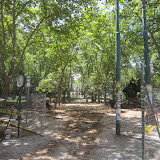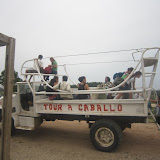Graffiti reading "Mujica is a murderer," painted over with "Mujica is President."
- I've become completely fascinated with one particular moment in Uruguayan history. During the late 1960's and early 1970's, President Jorge Pacheco Areco, amid a labor and economic crisis, suspended many constitutional protections and instituted military rule. The primary opposition came from the Tupamaro movement, a group of leftist guerillas looking to emulate the still-recent Cuban revolution. Among other things, Areco's government tortured its opponents, and threw many of them in jail, often without due process. Specifically, dissidents were imprisoned in the Punta Carretas prison. However, in September 1971, 111 political prisoners (including the new President-elect, Jose Mujica) escaped through a tunnel they had dug under the wall. Remarkably, there's a story of someone calling the police precinct to report the escape, informing the officer on the other end of the phone that 100 or so prisoners had just dug through his floor and left. The officer responded that none of the guards had seen anyone trying to escape, and admonished the citizen not to waste police time with any pranks. Presumably the officer was later fired. Punta Carretas, it's worth noting, is now one of the nicest neighborhoods in Montevideo. In one of the stranger metamorphoses I've heard of, the prison has been converted into a shopping mall. As you can see from my pictures, Punta Carretas Shopping ("shopping" is the word for "mall") still retains a good deal of the original prison architecture. At any rate, the story of the escape has grabbed my attention, so I've picked up a copy of Fuga de Punta Carretas, a book written by Eleuterio Fernández Huidobro, one of the escapees. I intend to make it the first book I read in Spanish, after I finish the book I'm currently reading in English. And for any of my friends in the film world, I am certain that this would make an excellent Hollywood screenplay.
- I've decided to stay in Montevideo through Tuesday. Not only will this give me the opportunity to see what Montevideo is like on a weekend, it will also allow me to attend Mujica's inauguration, which is at Plaza Independencia, a short walk from my school. Apparently Hillary Clinton is expected to be in town, which should be cool to see. From what I've heard, there are also likely to be a large number of parties and performances, something akin to the dozens of inaugural balls in the U.S. To me, however, as well as to a number of Uruguayans, the most fascinating thing is that Mujica has managed to be elected at all. It is important to note that the Tupamaros weren't political prisoners of the Nelson Mandela variety. As a group, they were rather violent. Many of them killed people. Mujica himself was convicted of killing a police officer. Moreover, the Communist dreams of the Tupamaros were never realized. Instead, they become more moderate, and formed a legitimate political party on the left side of the spectrum. So Mujica's election isn't the inevitable result of some steady stream of leaders forced on the country by the victors of the war. In that light, I find it truly remarkable that Mujica was elected, by a 9 point margin no less, to represent many of the same people with whom he was once at war. This is not, to be clear, a matter without controversy (as the picture above indicates). There are plenty of locals who are uneasy with Mujica's progression from guerilla to statesman. But on the whole, everyone I've met seems very excited about his potential as President. As a side note, after his escape from prison, Mujica was shot six times by police and taken back into custody. He was held for the next fourteen years. Two of those years were spent at the bottom of a well. As though that were not enough, I've also been told that the bullets were never removed. So I think he's probably earned his new job.
- One of the results of the success of the Tupamaros (now part of the Frente Amplio or "Broad Front" party) is that a lot of Uruguay's policy has something of a leftward lean. The primary example of this is the significant role of the state in many aspects of the lives of its citizens. Sometimes this shows up in ways that are somewhat expected--e.g. that Antel, the energy company, is state owned. Sometimes the effects are more subtle, such as in the case of Montevideo's lone amusement park--a river-side Coney Island type affair with some truly rickety attractions--which is state-run as well. The thing that I find most impressive, however, is that every student in a public Uruguayan elementary school is given a state-issued laptop. In addition to the usual hardware, the laptops are equipped with LoJack, which addresses any concerns of rampant theft that might otherwise spring up. The first group of students are entering middle school with their laptops this year, and the program has been an overwhelming success. Though it's obviously much easier to have government-mandated computers in a country of three million than in a country of 300 million, the United States could stand to take a lesson from Uruguay's efforts to ensure that its children aren't lapped by competetors in the internet age.
- As I've mentioned, the two major soccer teams here are Nacional and Peñarol. As opposed to just saying "I'm a Nacional fan" or "I'm a Peñarol" fan, the fans of the two teams have special nicknames. Fans of Nacional are "bolso," which stems from the pocket ("bolsillo" in Spanish) that historically adorned the Nacional jerseys. Peñarol fans are "manya," which actually stems from the Italian word "mangiare," which means "to eat." Peñarol fans were referred to by rivals as "manya mierda," which is a colorful term for people who eat excrement. The Peñarol supporters decided to reclaim the term, and now proudly wear shirts declaring "soy manya."
- This isn't a particularly Uruguay-specific thing, but last weekend in Cabo Polonio marked the fifth different incorrect spelling of my name I've come across in this trip. Spanish speakers have a really tough time both hearing and pronouncing the name Seth. I'm not too bothered by it, having grown up with grandparents who called me "Set," but it is amusing to see the wide range of ways there apparently are to butcher a one-syllable name. I'd already been Sef, Set, Sez (because in Spain, the "z" is used like the "th" in English), and Sed. In Cabo Polonio, I received my newest moniker, Serth. It's important to note that the pronunciation is using the Spanish version of the letter R, so it's not quite as far out there as it looks. Still. I'm excited to be at 5 names and still counting.
- I'd often heard that it was fairly easy for Portuguese speakers to learn Spanish and vice versa. I have learned that this is pretty true. In a very large number of cases, Portuguese sounds very much like Spanish with slightly different consonants. On the trip to Colonia, most of our tour group was Brazilian, so the tour guide spoke in Portuguese much of the time, and I found that I could follow a lot of what was being said. That said, Portuguese, to an English speaker, is a pretty bizarre sounding language. There are a lot of "sh," "zh," and "ch" sounds. I gave my Brazilian friends a hard time by claiming that I could translate Black Eyed Peas's "I Gotta Feeling" into Portuguese as follows: "I gotta feelin / that tonightch gonna be a goodch nightch / that tonightch gonna be a goodch nightch / that tonightch gonna be a goodch goodch nightch." I also learned that the Portuguese word for iPod is spelled the same as in English, but pronounced, as you might expect, "i-potch."
- I've been spending a lot of class time lately practicing the subjunctive, which is a tense that doesn't really exist in English. Or, to the extent that it does, we certainly don't have specific verb conjugations for it. Subjunctive is used, among other things, to express a desire or a wish, and one of the forms of doing that is to say "Ojala que [subjunctive form of thing that you want to happen]." This roughly translates as "I wish that [the thing will happen]." Interestingly, however, it comes from Arabic, from the phrase "Inshallah," praying that a certain event will come to pass. I had always noticed that Spanish contains a number of words that have a somewhat Arabic sound to them (e.g. the word for "carpet," which is "alfombra") but never managed to put together the
fairly obviousfact that theOttoman occupation of Spaininflux of North African immigrants into Spain starting in the 8th century* had a significant linguistic impact. For that reason, Spanish includes a number of words that are completely distinct from other Romantic languages--with the notable exception of Portuguese, because theOttoman ruleArabic influence covered the entire Iberian Penninsula. This was all explained to me last night by my friend Liz, so I thank her for that excellent contribution to my ever-expanding knowledge of random stuff.
- I'm hoping to get to one last murga show before I head off to Argentina, probably on Friday or Saturday. If you're interested, I tracked down the website of the excellent murga group I saw perform two weeks ago, Queso Magro.
Saludos,
Seth
* My father corrected me on this. Knowledge of random stuff expanded further.
Fotografía:
 |
| Montevideo |


























